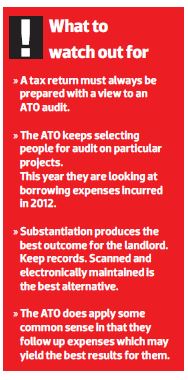Last month, we looked at what you can claim as a legitimate deduction before you buy your investment property and while holding it. This month we speak to Shukri Barbara to find out the tax claims that the ATO is targeting this year.
What makes a deduction eligible?
Because the ATO has a much-enhanced IT capability, it can compare figures year-on-year and follow up items exceeding its benchmarks through data matching.
It is also capable of matching what is reported on the tax returns with council and other third-party data. That is how the ATO audits people who do not declare capital gains on sale of property, including those selling non-income-producing land and holiday houses.
When is it best not to include a deduction?
Basically, it is in the instances where the amounts yield little tax savings and have no proper substantiation.
Most times, this is when you can only provide estimated figures such as for telephone and home office expenses, etc. Travel expenses when visiting rental property interstate while on holiday is another area of contention, as landlords try to claim airline and accommodation expenses while the ATO only allows for taxi travel/car expenses from hotel accommodation to the rental property address.
It is also best not to claim a deduction when the ATO has a ruling out or even a private ruling indicating that the expense is not deductible.
An example would be the case of claiming 100% of expenses related to seminars teaching how to create wealth, as these are generally incurred before the property is even owned.
Rental property expenses targeted by the ATO
Recently, ATO has focused on borrowing expenses related to rental properties as an audit target.
Landlords have received audit letters notifying them that the claims for deductions of borrowing expenses related to the 2012 financial year will be amended to nil unless the taxpayer can substantiate the claim.
Borrowing expenses are deductible over five years, or less if the loan term is shorter.
Substantiation involves revisiting the summary of expenses which make up borrowing expenses, including various fees related to loan establishment, stamp duty on mortgage, bank charges, legal, valuation, and various other charges related to the loan.
But the largest item, where incurred, is mortgage insurance which covers the bank should a tragedy happen to the borrower, causing a default on the loan.
Usually, many of these items appear on the first loan statement issued.
For a successful response from the ATO, it is best to produce a copy of the original documents showing the expenses, and a summary of the calculation matching the amount appearing on the tax return’s rental schedule for each property.

● Clients get into trouble when they don’t have copies of the relevant documentation, particularly when loans have been taken out several years prior.
● There may be difficulties where existing loan facilities for the main residence have been used to fund investment properties. The ATO is unable to clearly identify the expense relevant to the investment property.
● Lines of credit facilities are a particular problem where they are used to fund private purchases plus rental property expenses such as rates and repairs, and maintenance expenses including electrical, plumbing and handyman services. Most cases that we see do maintain clear records of what is related to the rental property and what is not.
● Distinguishing between what is deductible and what are depreciable capital expenses is sometimes difficult to determine. For example, consider the situation of fixing up a pergola. Generally, the value spent on the repair gives an indication of how it should be treated. A large amount indicates a depreciable capital expense, particularly after recent storms.
Mistakes the ATO looks for
Other mistakes the ATO is constantly watching out for are:
● Claims for interest payments, council and water rates and other property expenses for the full year where the property was only rented or available for rental for part of the year. For example, in relation to holiday houses, where rooms are rented out when the property is vacant but not available for rent, eg when preparing for a sale.
● Not declaring capital gains on sale of properties which never generated rental income but are not the main residence of the owner.
● Claiming legal fees on purchase as a deduction against rent in the first year of rental.
● Claiming the interest deduction on the borrowing expense label on the tax return.
● Claiming of expenses on vacant land – no income = no expenses.
● Claiming rental expenses on properties which are vacant but not available for rent.
● Borrowing expenses claimed all in one year instead of being apportioned.
.JPG)